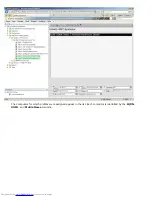
Back to Contents Page
System Deployment
Once you are ready to deploy a computer to a user, plug the computer into a power source and connect it to the network.
Use the integrated Intel
®
82566DM NIC. Intel Active Management Technology (Intel AMT) does not work with any other NIC
solution.
When the computer is turned on, it immediately looks for a setup and configuration server (SCS). If the computer finds this
server, the Intel AMT-capable computer sends a
Hello
message to the server (user must first activate network access either
via MEBx or using Intel Activator).
DHCP and DNS must be available for the setup and configuration server search to automatically succeed. If DHCP and DNS
are not available, then the setup and configuration servers (SCS) IP address must be manually entered into the Intel AMT-
capable computer's MEBx.
The
Hello
message contains the following information:
Provisioning ID (PID)
Universally Unique Identifier (UUID)
IP address
ROM and firmware (FW) version numbers
The
Hello
message is transparent to the end user. There is no feedback mechanism to tell you that the computer is
broadcasting the message. The SCS uses the information in the
Hello
message to initiate a Transport Layer Security (TLS)
connection to the Intel AMT-capable computer using a TLS Pre-Shared key (PSK) cipher suite if TLS is supported.
The SCS uses the PID to look up the provisioning passphrase (PPS) in the provisioning server database and uses the PPS and
PID to generate a TLS Pre-Master Secret. TLS is optional. For secure and encrypted transactions, use TLS if the infrastructure
is available. If you do not use TLS, then HTTP Digest is used for mutual authentication. HTTP Digest is not as secure as TLS.
The SCS logs into the Intel AMT computer with the username and password and provisions the following required data items:
New PPS and PID (for future setup and configuration)
TLS certificates
Private keys
Current date and time
HTTP Digest credentials
HTTP Negotiate credentials
The computer goes from the setup state to the provisioned state, and then Intel AMT is fully operational. Once in the
provisioned state, the computer can be remotely managed.
Back to Contents Page
Содержание OptiPlex 980 - Desktop
Страница 9: ......
Страница 31: ...2 Select Y to unconfigure 3 Select Full Unprovisioning and press Enter ...
Страница 67: ...4 Click the to expand the Intel AMT Getting Started section ...
Страница 68: ...5 Click the to expand the Section 1 Provisioning section ...
Страница 69: ...6 Click the to expand the Basic Provisioning without TLS section ...
Страница 72: ...The IP address for the ProvisionServer and Intel SCS are now visible ...
Страница 73: ...9 Select Step 2 Discovery Capabilities ...
Страница 74: ...10 Verify that the setting is Enabled If Disabled click the checkbox next to Disabled and click Apply ...
Страница 75: ...11 Select Step 3 View Intel AMT Capable Computers ...
Страница 76: ...Any Intel AMT capable computers on the network are visible in this list ...
Страница 77: ...12 Select Step 4 Create Profile ...
Страница 78: ...13 Click the symbol to add a new profile ...
Страница 82: ...15 Select the icon with the arrow pointing out to Export Security Keys to USB Key ...
Страница 83: ...16 Select the Generate keys before export radio button ...
Страница 90: ...27 Select Step 7 Monitor Provisioning Process ...
Страница 92: ...28 Select Step 8 Monitor Profile Assignments ...
Страница 95: ...Back to Contents Page ...




















